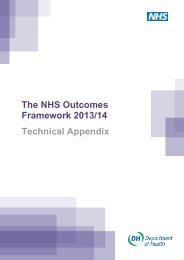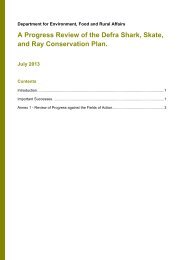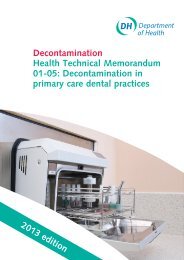A study of Patent Thickets (1.31Mb) - UK Intellectual Property Office
A study of Patent Thickets (1.31Mb) - UK Intellectual Property Office
A study of Patent Thickets (1.31Mb) - UK Intellectual Property Office
You also want an ePaper? Increase the reach of your titles
YUMPU automatically turns print PDFs into web optimized ePapers that Google loves.
36 A Study <strong>of</strong> <strong>Patent</strong> <strong>Thickets</strong><br />
The authors have to restrict analysis to the period 1986 to 1991 for their <strong>study</strong> due to changes<br />
in methodology in the underlying data. The <strong>study</strong> is undertaken at the establishment level, but<br />
firm level variables are taken into account in the econometric analysis. In 1986 there are 143,000<br />
establishments in the data. Focus <strong>of</strong> the <strong>study</strong> is on exit rates, i.e. on survival. Similarly to the<br />
US studies it is shown that the unconditional probability <strong>of</strong> survival declines with age. The decline<br />
is greater for single establishments which are typically smaller establishments. Once the authors<br />
condition on firms’ and establishments’ characteristics, they show that it is the firms’ initial size<br />
that reduces the probability <strong>of</strong> exit significantly. This effect gets weaker with age. Overall the<br />
<strong>study</strong> shows that in the <strong>UK</strong> as in the United States small firms are more likely to exit. However,<br />
this <strong>study</strong> does not show whether the probability is disproportionately higher for smaller firms.<br />
Also due to the econometric specification chosen it is hard to analyze the effects <strong>of</strong> age clearly.<br />
The authors find that after five years 65% <strong>of</strong> new establishments exit. For establishments that<br />
are part <strong>of</strong> multi-establishment firms this figure falls. Unfortunately the authors do not provide<br />
information on the extent <strong>of</strong> the reduction for such establishments.<br />
The <strong>study</strong> by Helmers and Rogers (2010) tracks the survival <strong>of</strong> a complete cohort <strong>of</strong> firms<br />
registered in Britain in 2001. Of the 162,000 firms in this cohort, just over 30% <strong>of</strong> the firms have<br />
exited after four years. The authors show that “IP active” firms (i.e. firms that have obtained<br />
either a patent or a trade mark) are significantly less likely to exit than other firms. This is true<br />
both in descriptive results provided and in results conditional on a large number <strong>of</strong> firm, sector<br />
and location specific controls.<br />
The papers reviewed here demonstrate that high rates <strong>of</strong> entry and exit are characteristic <strong>of</strong><br />
SMEs in the <strong>UK</strong> and elsewhere. The more recent literature notes that SMEs which survive<br />
beyond the first five years <strong>of</strong>ten make an important contribution to job growth and productivity<br />
improvements in an economy. Haltiwanger et al. (2010) also note the need for a better<br />
understanding <strong>of</strong> the challenges faced by SMEs in these first five years. The literature on the<br />
growth and patenting nexus discussed above suggest that firms’ decision to patent may<br />
contribute to their growth success, especially so in the case <strong>of</strong> first-time patentees. It is against<br />
this background that we analyze the effect <strong>of</strong> thickets on firms’ first-time patenting decision.

















